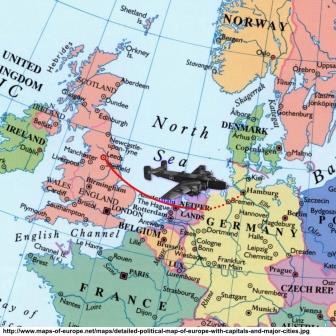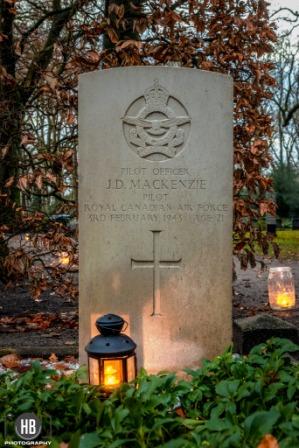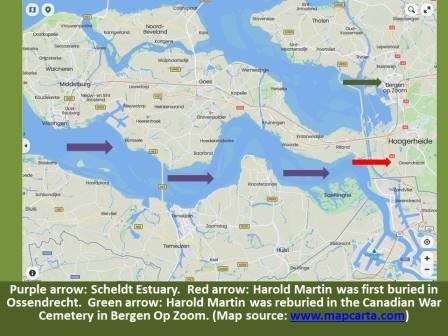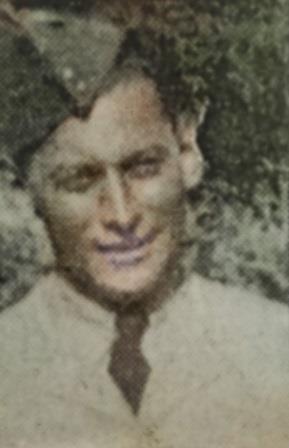February 27, 2023. After an interview about the photo quest for soldiers buried in the Canadian War Cemeteries in The Netherlands ran on APTN in 2021, Pieter was contacted by Patricia Saulis about Sanford Steven SAULIS of Maliseet, New Brunswick, who is buried in the Canadian War Cemetery in Holten, The Netherlands. (To read the APTN article, see https://www.aptnnews.ca/national-news/dutch-born-p-e-i-man-on-a-mission-to-find-photos-of-first-nations-soldiers-killed-overseas-in-wwii/)
“…My Uncle Sanford Saulis died on August 10, 1945 and is buried in Holten Cemetery…. Thank you for doing your work on this Project….” Patricia wrote.
…Sanford Saulis was on the photo wish list for the Canadian War Cemetery in Holten….
Sanford was on the photo wish list for the cemetery. Unfortunately, Patricia did not have a photo of her uncle. Then, a few months ago, Conrad Saulis wrote us. “…I was recently forwarded an email you sent to my sister Patty last year regarding our Uncle Sanford S Saulis, who is buried in the Holten Canadian War Cemetery in The Netherlands….
Rest assured that we have not forgotten him or the sacrifice he made to protect our Wolastoqey Nation traditional Ancestral lands from fascism. ….I too am on a quest to find a picture of him…”
Conrad explained that “….Sanford was my dad’s half-brother – he was born of a different mother before my dad was born…” After Sanford’s mother Suzan died in 1918, his father remarried.
Luckily, Conrad photo quest was successful. “….Woliwon. I am attaching a pic my niece got from a co-worker in Fredericton of Sanford …”

Sanford Steven Saulis. (Photo courtesy of the Saulis Family)
…Sanford was a member of the Maliseet First Nation….
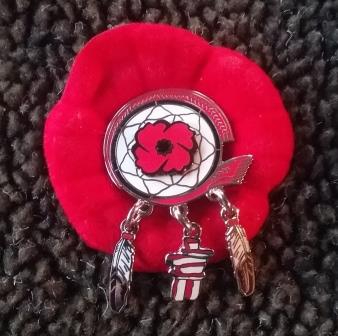 Born September 19, 1914, Sanford Steven SAULIS was the son of William and Suzan (nee Paul) Saulis, members of the Maliseet First Nation. Maliseet is the Mi’kmaq word for the Wolastoqey, members of the Wabanaki Confederacy, a group of Algonquian-speaking nations (See https://www.thecanadianencyclopedia.ca/en/article/maliseet and https://en.wikipedia.org/wiki/Madawaska_Maliseet_First_Nation)
Born September 19, 1914, Sanford Steven SAULIS was the son of William and Suzan (nee Paul) Saulis, members of the Maliseet First Nation. Maliseet is the Mi’kmaq word for the Wolastoqey, members of the Wabanaki Confederacy, a group of Algonquian-speaking nations (See https://www.thecanadianencyclopedia.ca/en/article/maliseet and https://en.wikipedia.org/wiki/Madawaska_Maliseet_First_Nation)
Before enlisting with the No. 7 District Depot of the Canadian Army in Perth, New Brunswick on May 22, 1941, Sanford worked as a hand stitcher at the Philco Shoe Company in Bangor, Maine, USA, and as a general construction labourer for various companies in New Brunswick and Maine. He also could drive a motorcycle.
In an interview for his Personnel Selection Card, he stated that he enjoyed swimming, skating, hunting, and canoeing. He also played team sports such as baseball and hockey.
On June 6, 1941, Sanford transferred to the 3rd Battalion (later converted to 4th Battalion) of the Royal Canadian Engineers and sent to Petawawa, Ontario for basic and advanced training.

Map shows location of Gourock, Scotland in the Firth of Clyde. (Map source: scotslanguage.com)
Sanford was soon on his way overseas with the 4th Battalion. They left Halifax, Nova Scotia on September 18, 1941, arriving in Gourock, Scotland on September 27, 1941. The Regiment was based at Guillemont Barracks in Hampshire, England. (See https://en.wikipedia.org/wiki/Guillemont_Barracks)
Sanford undertook general engineering duties in the Regiment, and attended a heavy bridge course in 1942. Likely this concerned learning about armoured vehicle-launched bridge vehicles, designed to lay down a bridge in combat.
On May 7, 1943 he was transferred to the 29th Field Company of the Royal Canadian Engineers. In March 1944 he was sent for a series of courses in driving Class ‘B’ vehicles, such as heavy armoured trucks, motorcycles, light reconnaissance vehicles, and tractors.
…Sanford went overseas with his Regiment after D-Day….
On July 5, 1944 he left the United Kingdom for France. By July 1945 he was in northwest Europe. On August 8, 1945, following a short hospital stay for treatment of dermatitis, Sanford was transferred to the 16th Field Company of the Royal Canadian Engineers.

Map shows Breukelen and Hilversum. (Map source: https://www.viamichelin.com)
The 16th Field Company was based at a camp near Breukelen, The Netherlands. The war diary for August 9, 1945 reported “…Heavy rain and 21oC…..” and that they were working towards getting the moat at Nyenrode Castle cleared of weeds. “…Some wood blocks linked together as a chain and towed by a row-boat does a fair job…” This was an example of the variety of tasks undertaken by the Royal Canadian Engineers in the aftermath of war. (See https://www.spottinghistory.com/view/3618/nyenrode-castle/)

Nyenrode Castle, with the moat surrounding it. (Photo source: https://www.castlesworld.com)
…Sanford lost his life due to a brain hemorrhage….
Unfortunately, that night, after Sanford went to sleep, a tragedy occurred. The war diary for August 10, 1945 recorded that there was “…a fatal accident in the camp; this morning the body of Lance Corporal SS SAULIS was discovered lying on the ground under the window of his room. He was dead but there were no signs of how he met his death; only a small abrasion on his face, and no broken bones….The window was only 15 feet above the ground…”
On August 12, 1945 the war diary noted the results of a post-mortem. Sanford “…died of a hemorrhage of the brain. This probably caused, and was not caused by, the fall, which explains the lack of signs of any effort …. to save himself…”
The post-mortem report concluded that Sanford had died 3-4 hours before his body was found at 8:00 am on August 10, 1945. Most likely he had gotten up in the night, suffered a brain hemorrhage, and tumbled out the open window.
Sanford was initially buried in the Canadian Section at Hilversum Civil Cemetery. According to the war diary, his funeral was held on August 13, 1945 at 10:00 am, “…with Honorary Captain BUTLER officiating. Major MAIN and CARSON (former OC of the deceased) also attended. Lt E. BRACCI was also on hand to pay last respects…”
…Sanford was reburied in the Canadian War Cemetery in Holten….
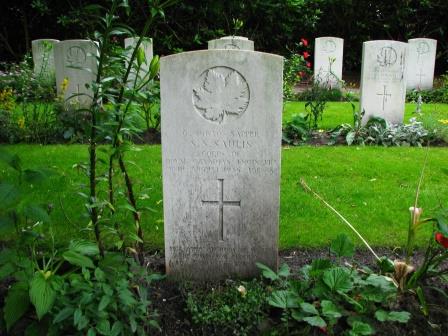
Grave of Sanford Steven Saulis in Holten, The Netherlands. (Photo courtesy of the Information Centre Canadian Cemetery Holten)
Sanford was later reburied in the Canadian War Cemetery in Holten, The Netherlands. Conrad Saulis wrote that “…My dad (Herman) – also a veteran of WWII -once was able to visit his brother’s grave in Holland and on his return from a Canadian celebration over there was very glad that he had found the grave. My dad is deceased and like many other vets told very few stories of his war experiences….”
It’s important to recognize that Indigenous soldiers were all volunteers, a point that Conrad noted. “…As First Nation (Indian) people they did not have to enlist and could not be conscripted to join the army – it was all on a voluntary basis. When my dad and his brother volunteered they did not lose their ‘status’ and neither did my Grandfather William for WWI…”
Thank you to Patricia Saulis for initially contacting us about her uncle, and to Conrad Saulis for sharing his photo. Conrad wrote “…I am encouraged by your work to remember all of the veterans buried overseas….” It is an honour for us to research and tell the stories you read on this blog.

Conrad went on to say that “… I have a ‘bucket list’ task of visiting my Uncle’s grave in the Holten cemetery and to honour his spirit, grave site and headstone with a traditional prayer and blessing (smudge) of our sacred First Nation herbs gathered from Mother Earth. It is never too late for this to happen as he continues his Spirit Life and Walk the traditional blessing is to support his ongoing safety in the Spirit World…” We hope that Conrad is able to make this visit and will share it with us.
If you have a story to tell, please let Pieter know. Email him at memorialtrail@gmail.com, comment on the blog, or tweet to @researchmemori1.
© Daria Valkenburg
…Want to follow our research?….
If you are reading this posting, but aren’t following the blog, you are welcome to do so. Our blog address: https://onthewarmemorialtrail.com/.
 4 countries, 6 weeks, 7,000 km – an unforgettable war memorial journey in Europe…. Daria’s book ‘No Soldier Buried Overseas Should Ever Be Forgotten‘ is available in print and e-book formats. Net proceeds of book sales help support research costs and the cost of maintaining this blog. For more information see https://nosoldierforgotten.com/
4 countries, 6 weeks, 7,000 km – an unforgettable war memorial journey in Europe…. Daria’s book ‘No Soldier Buried Overseas Should Ever Be Forgotten‘ is available in print and e-book formats. Net proceeds of book sales help support research costs and the cost of maintaining this blog. For more information see https://nosoldierforgotten.com/
You are also invited to subscribe to our YouTube Channel: On The War Memorial Trail With Pieter Valkenburg: https://www.youtube.com/channel/UCJ591TyjSheOR-Cb_Gs_5Kw.
Never miss a posting! Subscribe below to have each new story from the war memorial trail delivered to your inbox.


